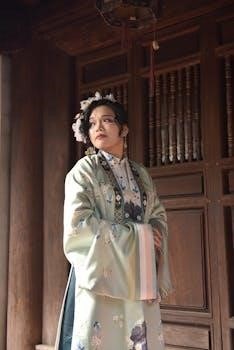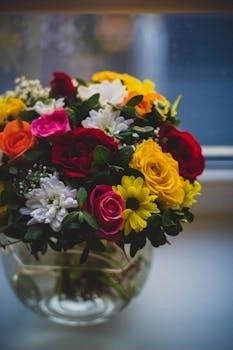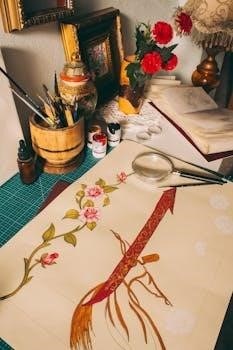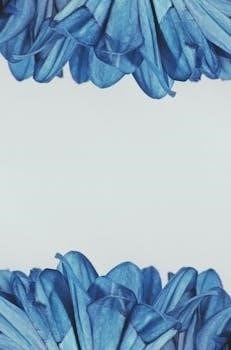the aifd guide to floral design
The AIFD Guide to Floral Design⁚ A Comprehensive Overview
The AIFD Guide to Floral Design serves as the ultimate reference, encompassing everything from plant physiology to design elements, and cut flower care. It’s a meticulously compiled compendium for serious floral designers. It prepares individuals for the Professional Floral Design Evaluation (PFDE) and subsequent AIFD certification.
What is the AIFD Guide to Floral Design?
The AIFD Guide to Floral Design is the definitive resource for floral professionals. It’s a comprehensive compendium meticulously crafted to serve as the ultimate reference for everything related to the art and science of floral design. Forget browsing scattered articles; this guide consolidates essential knowledge in one accessible volume.
Consider it your go-to source, covering a vast spectrum of topics vital to success. From the intricacies of plant physiology, understanding how plants function and react, to the fundamental elements and principles that govern aesthetically pleasing designs, this guide leaves no stone unturned. Moreover, it provides invaluable insights into the proper care and handling techniques necessary to extend the life and beauty of cut flowers.
This guide goes beyond mere aesthetics; it delves into the technical aspects, providing the knowledge base needed to create lasting and impactful floral arrangements. It’s not just a book of pretty pictures; it’s a treasure trove of information, making it an indispensable tool for anyone serious about mastering the craft and achieving accreditation. Aspiring floral designers will find it an essential companion on their journey to becoming certified professionals.
Content Overview⁚ Terms, Techniques, and Traditions
The AIFD Guide to Floral Design is structured to provide a thorough understanding of the floral design world, encompassing essential terms, time-honored techniques, and rich traditions. It begins by establishing a solid foundation of terminology, ensuring that designers have a common language for effective communication and understanding of design principles. This includes defining various floral forms, styles, and the tools of the trade.
Delving into techniques, the guide presents a comprehensive overview of the methods used to construct and arrange floral designs. From basic wiring and taping to advanced techniques like pave and layering, each method is explained in detail with illustrative examples. The book emphasizes the importance of mastering these techniques to create structurally sound and visually appealing arrangements.
Moreover, the guide acknowledges the significance of traditions in floral design, exploring the historical and cultural influences that have shaped various styles and customs. Understanding these traditions adds depth and meaning to designs, allowing designers to create pieces that resonate with specific occasions and sentiments. It is a complete walkthrough of all of the design elements, and how they play a part in a design coming together as a whole. These traditions are a key point in any floral design.
The Importance of Plant Physiology in Floral Design
A deep understanding of plant physiology is paramount in floral design, influencing both the aesthetic appeal and longevity of arrangements. Knowing how plants function at a cellular level allows designers to select appropriate materials, predict their behavior, and manipulate environmental factors to extend vase life. This knowledge encompasses various aspects, starting with water relations. Designers must understand how plants absorb, transport, and transpire water to prevent wilting and ensure hydration.
Photosynthesis is equally crucial, as it dictates the plant’s energy production and overall health. Understanding the light requirements of different flowers and foliage enables designers to create environments that support their metabolic processes. Furthermore, knowledge of plant hormones, such as ethylene, is essential for managing ripening and senescence. Ethylene accelerates the aging process in many flowers, so designers must employ strategies to minimize its effects, like using anti-ethylene treatments or selecting ethylene-insensitive varieties.
Nutrient requirements are also critical. While cut flowers don’t rely on soil for sustenance, providing appropriate floral preservatives with essential nutrients can significantly extend their vase life. By understanding the physiological needs of different plant species, floral designers can create arrangements that are not only beautiful but also sustainable, ensuring maximum enjoyment for their clients. In essence, plant physiology is the key to unlocking the full potential of floral artistry.

Mastering Design Elements and Principles
Mastering design elements and principles is fundamental to creating visually compelling and harmonious floral arrangements. These elements—line, form, space, texture, color, and size—serve as the building blocks of any design, while the principles—balance, proportion, harmony, unity, rhythm, and dominance—guide their arrangement to achieve a cohesive and impactful composition.
Line, for instance, dictates the visual pathway and creates movement within the design, whether it’s a strong vertical line for height or a gentle curve for elegance. Form refers to the three-dimensional shape of the arrangement, requiring careful consideration of the individual components and their spatial relationships. Space, both positive and negative, defines the areas occupied and unoccupied by floral materials, contributing to the overall balance and visual interest. Texture adds tactile and visual depth, creating contrast and enhancing the sensory experience. Color evokes emotion and sets the tone of the arrangement, requiring a thorough understanding of color theory and complementary palettes.

Finally, size dictates the scale of the arrangement and its individual components, ensuring proportionality and visual hierarchy. By skillfully manipulating these elements according to the guiding principles, floral designers can craft arrangements that are not only aesthetically pleasing but also convey a specific message or emotion, elevating their work from simple bouquets to true works of art. A strong grasp of these concepts is vital for success.
Cut Flower Care and Handling Techniques

Proper cut flower care and handling techniques are essential to maximizing the vase life and beauty of floral arrangements. These techniques encompass a range of practices, from the moment flowers are harvested to their final display, ensuring they remain vibrant and fresh for as long as possible. Initial steps involve using clean, sharp tools to make clean cuts at a 45-degree angle, allowing for optimal water uptake. Removing foliage below the waterline prevents bacterial growth and ensures the water remains clean.
Hydration is paramount, requiring the use of a floral preservative in cool, clean water. Floral preservatives provide essential nutrients and inhibit bacterial growth, extending the life of the flowers. Storing flowers in a cool environment, away from direct sunlight and drafts, further slows down the aging process. Regularly changing the water and re-cutting stems helps maintain hydration and prevents the buildup of harmful bacteria.
Specific flowers may require unique handling techniques, such as searing the stems of certain milky-stemmed flowers to prevent sap from blocking water uptake. For others, gentle misting can help maintain humidity and prevent dehydration. By adhering to these best practices, floral designers can ensure their creations remain stunning and long-lasting, providing clients with exceptional value and enjoyment. Mastering these techniques is crucial for any professional in the floral industry.
Path to Becoming a Certified Floral Designer (CFD)
The journey to becoming a Certified Floral Designer (CFD) is a structured process designed to recognize and validate the skills and knowledge of floral professionals. Aspiring CFDs must demonstrate a comprehensive understanding of floral design principles, techniques, and industry best practices. The initial step typically involves acquiring a solid foundation in floral design through formal education, workshops, or practical experience.
A key component of the CFD path is thorough preparation, often involving studying resources such as the AIFD Guide to Floral Design⁚ Terms, Techniques, and Traditions. This guide serves as a comprehensive reference, covering everything from plant physiology to design elements and cut flower care. Candidates then typically apply to undertake the Professional Floral Design Evaluation (PFDE), which assesses their practical design skills and theoretical knowledge.
Successful completion of the PFDE, or alternatively, completing approved floral design education programs at an AIFD Education Partner followed by passing an online test, grants the CFD designation. Maintaining CFD status requires ongoing professional development through continuing education units (CEUs), ensuring that designers stay current with industry trends and techniques. The CFD designation signifies a commitment to excellence and provides recognition within the floral design community.
Continuing Education Requirements for AIFD and CFD Members
To maintain the prestigious status of either an Accredited Member of AIFD or a Certified Floral Designer (CFD), individuals must adhere to specific continuing education requirements. These requirements ensure that members remain current with the latest trends, techniques, and best practices within the ever-evolving floral design industry. AIFD members are typically required to complete continuing education every five years, while CFDs must fulfill these requirements every three years.
Continuing education can be obtained through various avenues, including attending workshops, seminars, and industry events. Many AIFD Education Partners offer courses that provide valuable CEUs. Members are responsible for tracking their CEUs and reporting them to the AIFD or relevant certifying body within the specified timeframe.
The specific number of CEUs required varies, and it’s crucial for members to consult the AIFD website or relevant documentation for the most up-to-date information. Failure to meet the continuing education requirements can result in the loss of AIFD or CFD accreditation. By actively engaging in continuing education, AIFD and CFD members demonstrate their commitment to professional growth and maintaining the highest standards of floral design excellence. This commitment ultimately benefits both the individual designer and the floral industry as a whole.
The Professional Floral Design Evaluation (PFDE) Exam

The Professional Floral Design Evaluation (PFDE) exam serves as a crucial step for aspiring floral designers seeking to achieve the coveted Certified Floral Designer (CFD) designation and potentially, accreditation within the American Institute of Floral Designers (AIFD). This rigorous evaluation assesses a candidate’s comprehensive understanding of floral design principles, techniques, and their ability to execute creative and technically sound floral arrangements.
The PFDE exam typically involves both a written component, based on the knowledge acquired from resources like the AIFD Guide to Floral Design, and a hands-on design component. During the hands-on portion, candidates are tasked with creating floral designs that meet specific criteria, demonstrating their mastery of elements and principles of design, color theory, and construction techniques. Evaluators meticulously assess each design based on established standards, considering factors such as balance, harmony, proportion, and originality.
Success on the PFDE exam signifies a designer’s readiness to excel in the floral industry and positions them for further advancement, potentially leading to AIFD accreditation. Thorough preparation, including in-depth study of the AIFD Guide to Floral Design and extensive practice in floral design techniques, is essential for achieving a passing score on this challenging but rewarding exam.
